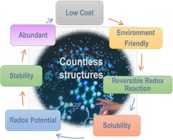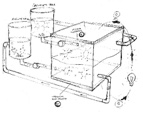Redox Flow Batteries
Redox-Flow Batteries (RFB) offer a unique feature: independent scalability of energy and power. In our research group, we work on the following research lines:
- Vanadium Redox Flow Batteries (VRFB); using low cost components to obtain a prototype technically and economically viable. We have recently designed and assembled a prototype 5-cell flow battery with large electrodes (3600 cm2) with capacity to store 2.5 kWh of energy at 1.8 kW power. Moreover, we assembled a stack of 100 cells with electrodes of the same dimensions to connect 3 of these stacks in series and perform a testing program for utility-scale solar power plants. The group works also with a process for the preparation of vanadium electrolyte from low cost raw materials. This application reflects the interest of the unit in using fundamental research that can be transferred to the industry.

- Organic-based RFB; Efforts are focused on finding new, reversible, highly soluble and stable organic redox species (including redox polymers) in aqueous and non-aqueous based electrolytes. Due to the overwhelming number of possibilities, we make use of computational chemistry to guide our experiments. We establish three sublines in this topic: i) development, optimization and validation of new flow cell systems, ii) search of high-performing electroactive species, iii) understanding of key processes that limit the performance.
- Membrane-free RFB; The ultimate objective of this research line is to completely remove the problematic membrane of RFBs by developing a disruptive, versatile and scalable Membrane-Free RFB implementing efficient and immiscible metal-free catholytes and anolytes based on redox active organic molecules. This research line is accomplished within the frame of an ERC Consolidator grant (https://cordis.europa.eu/project/rcn/209738_es.html).

- Microfluidic RFB; We work on the development of miniaturized flow battery that relies on microfluidic concepts such as laminar flow of electrolytes through microchannels. Different battery chemistries and designs fabricated using 3D printing techniques are being investigated making use of Computational Fluid Dynamics simulation tools.
Selected publications:
Energy Storage Materials
DOI: 10.1016/j.ensm.2019.11.011
Operational Experience of 5 kW/5 kWh All-Vanadium Flow Batteries in Photovoltaic Grid Applications Batteries, 2019, 5(3), 52
Patents:
Inventors: E. Ventosa, T. Paez, J. Palma.
R&D Projects:
MFreeB - Membrane-Free Redox Flow Batteries

![]() The MFreeB project proposes a disruptive, versatile and scalable redox flow battery in which the expensive and low performance ion-exchange membrane, which serves as selective separator, is totally eliminated due to the development of immiscible redox electrolytes. Moreover, the currently used vanadium pairs that are toxic and expensive are replaced by cheap, abundant and environmental-friendly organic molecules. New thermodynamic, fluid-dynamic and engineering aspects, never considered before in energy storage, will become key players in the development of this technology that constitutes a paradigm shift in energy storage.
The MFreeB project proposes a disruptive, versatile and scalable redox flow battery in which the expensive and low performance ion-exchange membrane, which serves as selective separator, is totally eliminated due to the development of immiscible redox electrolytes. Moreover, the currently used vanadium pairs that are toxic and expensive are replaced by cheap, abundant and environmental-friendly organic molecules. New thermodynamic, fluid-dynamic and engineering aspects, never considered before in energy storage, will become key players in the development of this technology that constitutes a paradigm shift in energy storage.
MIBAMIN – Research and Study of Micro Flow Batteries to be Coupled with Photovoltaic Micro Inverters
This project aims to develop microfluidic devices to be implemented as efficient micro flow battery using conventional vanadium active species. This flow battery will be integrated with a micro inverter in a modular system to be coupled with individual solar PV panels.
GEOBATT - Hybridization of geothermal energy and flow batteries for heating and cooling of zero-energy tertiary buildings
The project aims to develop a new energy technology for heating and cooling of buildings based on the hybridization of the energetic utilization of Earth’s subsoil and the energy storage in flow batteries.
LPT - The Total Photovoltaic Plant. Project to equip the photovoltaic plants with a platform that allows their maximum level of energy management
The "Total Photovoltaic Plant (LPT)" aims to address many of the problems of network integration of renewable and photovoltaic solar energy in particular. The fundamentals are different technologies used in power electronics, electrochemical storage and advanced control systems.


